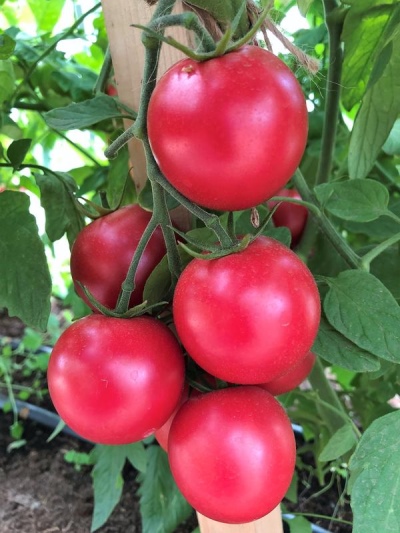
- Authors: Blokin-Mechtalin V.I.
- Year of approval: 2019
- Category: hybrid
- Growth type: determinant
- Appointment: fresh consumption
- Ripening period: ultra early
- Ripening time, days: 85-90
- Growing conditions: for film greenhouses
- Bush height, cm: about 70cm
- Leaves: short, dark green in color
Quite a lot of tomatoes from the "raspberry" family are already known. But even among them there are relatively new varieties that are not yet very familiar to gardeners. Meanwhile, today's hero - the Raspberry Farmer - can be an excellent choice for summer residents in different parts of Russia.
Breeding history
The creator of the plant is the already very widely proven Blokin-Mechtalin. The culture was entered into the State Agrarian Register in 2019. It was prepared at the breeding facilities of the agrarian company "Partner", founded in 2014. This is a very attractive hybrid in many ways.
Description of the variety
For the Raspberry farmer, the determinant scheme of the development of the bushes is typical. Plants rise to about 0.7 m. Shortened leaves develop on them. The foliage itself has a pronounced dark green color. The culture does not have any other botanical features.
Growing is possible on the territory:
- West Siberian, East Siberian and Far Eastern areas;
- Ural;
- Volga region;
- Central Black Earth Region;
- center, south, north and northwest of the European part of the Russian Federation.
The main qualities of the fruit
At the very beginning of vegetative development, tomatoes are green. Another characteristic feature at this moment is a dark green formation. When ripe, tomatoes weighing 0.05-0.06 kg will have a "generic" raspberry color. They are formed strictly on intermediate inflorescences, above the 7th leaf, and after that - every 2 leaves. Geometrically, the Raspberry Tiller is close to a simple circle and not too much ribbed; in the brush - 6, 7 or even sometimes 8 tomatoes.
Taste characteristics
The Raspberry Tiller leaves a sweet sensation. It is mixed with a light, but not too disturbing sourness. The pulp in the fruit is dense. Since the peel is thin, there is no need to talk about its significant contribution to the taste picture.
Ripening and fruiting
Russian gardeners may well be encouraged by the fact that the Raspberry Farmer is one of the ultra-early varieties. Usually, between the formation of the first shoots and the ability to harvest, it takes from 85 to 90 days. But this data may be incorrect in a particular year, because there are too many factors involved.
Yield
The ability to produce up to 10 kg of berries per 1 sq. m. As always, it should be noted that this indicator is strongly limited by the actual weather. The role of agrotechnical preparation of the garden and vegetable garden, however, also cannot be ignored.
The timing of planting seedlings and planting in the ground
Sowing seeds in containers is possible from the end of February. The soil mixture is selected individually. At the stage of seedling development, lighting should be provided for at least 15-16 hours.
Transfer to open ground is carried out not according to a formal calendar schedule, but when the danger of frost at night ends. Depending on the weather, this can happen 50-65 days after sowing.

Growing tomato seedlings is an extremely important process, because it largely depends on whether the gardener can harvest at all. All aspects must be taken into account, from seedbed preparation to planting in the ground.
Landing scheme
It is not allowed to place more than 5 bushes per 1 sq. m. Overloaded beds will still not give a good result, even with careful care. Otherwise, they act at their own discretion.

Growing and care
There is no particular need to remove stepchildren if the tomato does not overgrow. Formally, this variety can withstand severe temperature changes. But experienced summer residents try to play it safe and use greenhouses wherever temperature fluctuations can be significant. Gardening beginners can only follow this example. The same goes for the declared resistance to verticillium and fusarium wilting - additional protection measures will never be useless.
Watering the bushes should be 2 to 4 times a week. As always, they are guided by the weather and the actual need. Top dressing is applied both by root and leaf methods. The lower leaves are harvested after ripening fruits close to the ground. Necessarily need treatments to protect against:
- whitefly;
- Colorado potato beetle;
- scoops;
- aphids.




A plant needs different micronutrients at each stage of growth. All fertilizers can be divided into two groups: mineral and organic. Folk remedies are often used: iodine, yeast, bird droppings, eggshells.
It is important to observe the rate and period of feeding. This also applies to folk remedies and organic fertilizers.



























































































